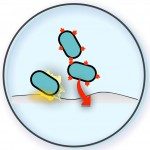Lien vers Pubmed [PMID] – 19400787
Mol. Microbiol. 2009 May;72(3):724-40
Biofilms are microbial communities characterized by three-dimensional growth resulting from the ability of individual cells to adhere to each other as well as to produce an extracellular matrix that ensures biofilm physical cohesion. Numerous bacteria produce cellulose as a biofilm matrix polymer, a property relying on the expression of bacterial cellulose synthesis (Bcs) proteins and their post-translational activation upon binding of cyclic di-guanosine mono-phosphate second messenger (c-di-GMP) produced by diguanylate cyclases. In Escherichia coli and other Enterobacteriaceae, two genes of unknown function, yhjR and yhjQ, are located upstream of the bcs genes. Here, we show that yhjQ, but not yhjR, is essential for cellulose biosynthesis; it has therefore been renamed bcsQ. Using a green fluorescent protein (GFP) fusion approach, we demonstrate that BcsQ, a MinD homologue, displays a polar localization and that cell-to-cell adhesion is initiated through production of cellulose at the BcsQ-labelled pole. Although we did not detect a similar localization for other Bcs proteins, immunogold labelling of cellulose itself at the pole of individual bacteria indicates the localized activity of the cellulose biosynthesis apparatus. These results therefore suggest that BcsQ could participate in spatial restriction of cellulose biosynthesis activity in Enterobacteriaceae.


